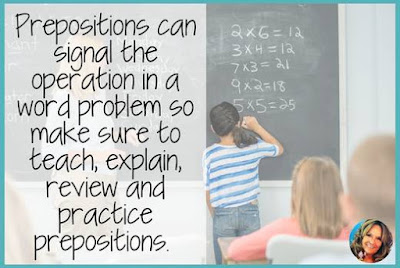Do your English Language Learners (ELLs) struggle with understanding Math? Many ELLs do. If you are an ESL teacher working with English Language Learners (ELLs) studying Math there are a few things to make sure you cover!
Consider common English words that may have more than one meaning when it comes to math or the use of prepositions, plus the general math vocabulary that can be a challenge too. Read on for more details on how to teach ESL math vocabulary with different math strategies to support the English Language Learners in your classroom.
Common English Words in Math
ESL students may have knowledge of a variety of new-to-them English words but throw in a new context and the challenge increases. So first let's look at the many English words that have totally new meanings when used in Math. Here are just a few:
positive and negative
times
cone
mean
net
bring down
area
face
plane
tree
Students might have an understanding of these terms in general ways but it is still essential to take a moment before each lesson to review your plans for such vocabulary. Take a look at the Math-specific vocabulary you are using in your lesson. Identify which words you want to point out and make sure to explain each one for its new context. For example, students should think 'multiplication' when a word problem uses words like times, every, double, and per. Practice multiplication and build Math fact fluency in your classroom with Multiplication Timed Tests Bundle - Factors 0 - 12. This easy no-stress way is everything you need for multiplication practice and to assess your students’ basic facts in multiplication all year long!
Maintaining a list of such words for yourself and for students will help to raise the flag when these words arise as your math lessons continue. For additional ways to teach vocabulary (and more) in your ESL classroom check out this post.
Prepositions in Math
Make a point to teach, explain, review and practice prepositions. Prepositions can signal the operation in a word problem since the role of a preposition is to express a relationship with the noun or clause in the statement. As part of your ESL math vocabulary plans, make sure your ELLs understand these important words in Math:
by
with
to
into
from
and more!
Teach ELLs Content Words
All students benefit from using a Math Vocabulary Journal, but it is an essential math strategy for the ELLs in your Math classes to have an ESL Math Vocabulary Journal.
Before each unit, present the ESL Math vocabulary that will be used in that unit. Pre-teaching math content words and using a math journal will set your ELL students up for success.
Math Prefixes and Suffixes
Don't forget word parts that are key to the meanings of the words you use in your math lessons. A review or refresh lesson when these prefixes are included in a lesson is ideal as part of your approach to ESL math vocabulary.
Here are a few to get you started:
bi- meaning two or twice
tri- meaning three or three times
poly- meaning many
oct- meaning eight
gon meaning a shape that has a specific number of angles or sides (e.g. octagon is a shape with eight angles or sides)
Passive Voice
Many ELLs are unaccustomed to hearing and understanding the passive voice, yet many math word problems use it. The word ‘by’ gives a clue to the passive. In the passive voice, the action is performed on the subject. ELLs have problems understanding statements such as: seven multiplied by 6. Another math strategy is to point out and explain the passive voice to your students when it occurs in math word problems.
Check out these 6 games that focus on regular past tense of -ed verbs. This series of games can serve as background for the ESL students in your classroom so they’re more comfortable with passive voice.
ESL Math Vocabulary for Mathematical Operations
The Limited English Proficient (LEP) Students: A Supplemental Resource to the K-12 Mathematics Standards of Learning Enhanced Scope and Sequence from the Virginia Department of Education indicates that in order to understand mathematics, students must “know which mathematical operations are associated with specific words.”
Some of the main ESL math vocabulary terms that students should know include a variety of words that are synonymous with addition, subtraction, multiplication, division, and equal.
Here’s a list that can help you get started with your ELL students:
Addition: add, plus, and, combine, sum, total of, more than, increased by, greater than
Subtraction: subtract, minus, less, less than, fewer than, decreased by, difference, lower, take away, from, shorter
Multiplication: multiply, times, product, as a factor, twice, double, triple, groups of
Division: divide, divided by, quotient, separated into equal groups, shared equally, over, into, how many groups
Equal: is, are, result, make
You can check out quick lists from www.englishstudyhere.com that can support more of your lesson preparations.
This is just the start of ways that you can help your English language learners excel in Math! Additional supports for ESL math vocabulary and so much more can be found in this K-5 year-long ESL curriculum mega bundle.






No comments:
Post a Comment